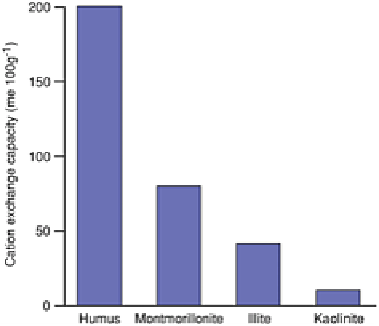Environmental Engineering Reference
In-Depth Information
Figure 18.10
The cation exchange capacities of humus and
common soil clay colloids.
which is derived from plant and animal remains which are added to the soil surface and
which are decomposed by soil organisms. The organisms range from the larger soil fauna
(earthworms, ants) to soil micro-organisms (bacteria, fungi, actinomycetes). The
decomposition of the fresh organic material is the process of
humification
, and results in
a dark-coloured amorphous material known as
humus
which gives the surface soil its
dark colour. It is not an easy material to study, and its chemistry varies, depending upon
the prevailing soil conditions and the nature of the original plant material. During the
course of humification the original plant material quickly loses the most readily
decomposed fractions (sugars, polysaccharides, amino acids), although it takes longer to
break down the more resistant carbohydrates (celluloses). The most resistant fraction of
lignin tends to accumulate in humus.
During humification, the many organisms and microorganisms in soil are also
synthesizing organic molecules (proteins, polysaccharides) which are added to SOM on
Table 18.7 Cation exchange values for various soils
Exchangeable cations (me 100 g
−1
)
Soil
Ca
Mg
K
Na
H
CEC
% BS
pH
Cambisol (Scotland)
3·0
27·5
0·2
0·1
3·6
34
90
6·5
Chernozem (Russia)
30·5
1·8
0·5
0·2
0
33
100
7·3
Podzol (Scotland)
0·6
0·7
0·2
0·1
37
39
4
4·3
Ferralsol (Kenya)
4·8
1·2
0·3
0·2
3·5
10
65
5·5
Luvisol (Canada)
22·8
0·6
0·3
0·1
3·8
28
86
6·2








